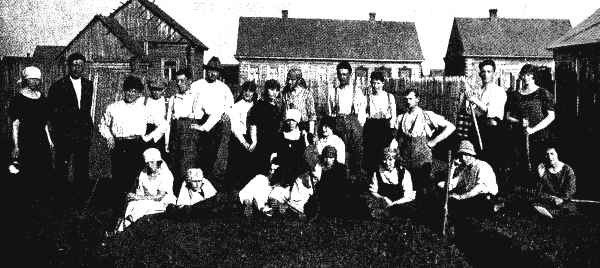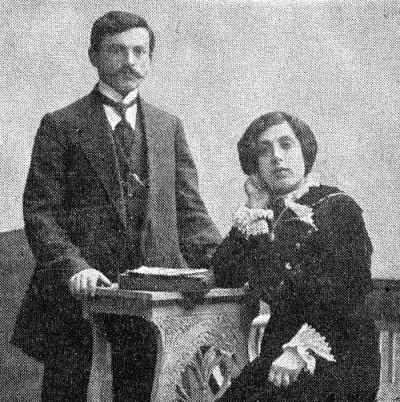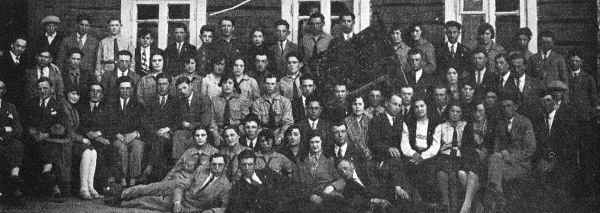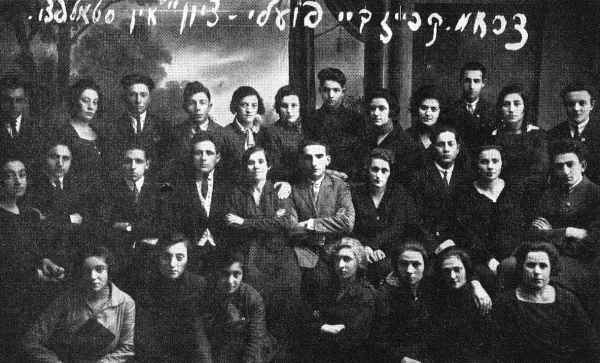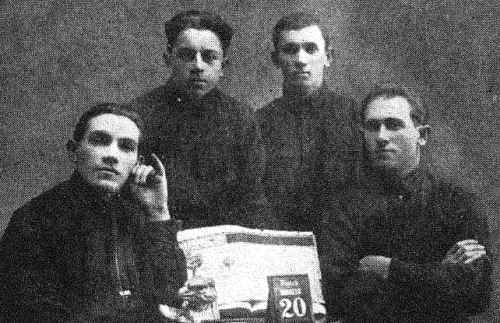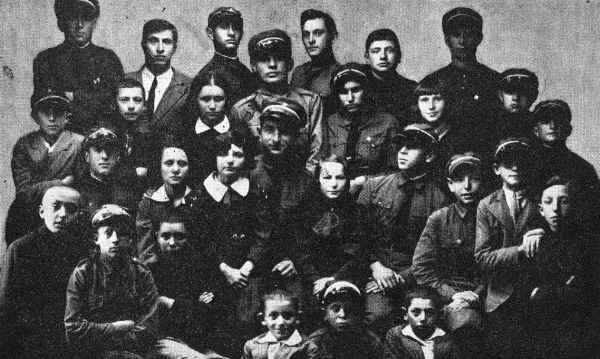[Page 225]
Movements and Parties
The Political-Social Life
by Mordechai Machtey
Translated by Esther Libby Raichman
With the beginning of the 20th century, the new winds that blew in Russia with regard to the revolutionary movement were also noticeable among the Steibtz Jewish population. Already in 1898 about 50 shekel (Israeli currency) were distributed in Stoibtz, and Stoibtz together with the town of Koidanov sent H. Mirles as a delegate to the 2nd Zionist Congress. If we take into consideration that one shekel was worth about 50 kopeks, approximately half a week’s expenses, then one can assess the magnitude of this achievement. This was made possible by the dedicated activity of Alter Yosselevicz, Mordechai Maharshak and my brother Aharon, of blessed memory. Two to three years later, Alter Yosselevicz organized the Women’s Zionist organisation under the name of “Bnot Tzion” (“Daughters of Zion”) that numbered close to 200 women members. A short time after that the “Bund” was organized in Stoibtz, whose founders and actual leaders were Hirshl Neufeld, Yosef Ber, Shimon the son of the teacher, and Yisroel-Leib Dvoretzki. But the actual powers of the “Bund” were the female intellectuals, the Rubashovs, the Ivianskis and Ginzburg’s daughters. Because of their social standing as wealthy or half-wealthy daughters, they contributed greatly to the development of the “Bund” and increased its domain of activity. Approximately in the year 1902, the “Poalei Tzion” (Minsk division) was organized, whose organizer and relentless worker was Pinye Kushner (the son of Slovve), with the assistance of Boruch Aginsky and Tuvia Shimon, the son of the teacher.
The establishment of the 3 parties brought a spiritual upheaval to the town. The contemptuous attitude to the tradesmen disappeared; on the contrary, they became the ones that the labour parties wanted to draw into their ranks. The spirit of the new times was also noticeable in the houses of study: the more the numbers of party members increased – the more the visitors to the study houses decreased: the more the demand for books increased in the library – the less one heard the expression, the Rabbi said, the father said: the more the number of debates and discussions between the parties grew, the less the disputes.
It is understandable, that the new winds that began to blow, did not escape me. At quite an early age, I left the Yeshivot where my father sent me, as he wanted me to be educated as a Rabbi. Instead of sitting and studying Gemorrah all day, I gradually began to devote my time to learning Hebrew and Russian and reading books in the library. In this way I became acquainted with the proclamations (leaflets) written on thin cigarette paper that I received quietly and secretly in the other language. The leaflets, both from the “Bund” and from “Poalei Tzion”, influenced me considerably with their demand for rights and justice and against oppression. My education in the Zionist children’s groups on the one hand and the ideals of Isaiah and the other prophets on the other hand, prepared me psychologically for the “Poalei Tzion” movement.
The Rise of ‘Poalei Tzion‘ (Workers for Zion)
As already mentioned above, the Poalei Tzion movement was organized in 1902 by the friends: Pinye Kushner (son of Slovve), Boruch Aginsky, and Tuvia Shimon the teacher’s son. In the summer of 1904 one of the friends invited me to a gathering that took place on a Sabbath afternoon in the Zadvorier forest.
I waited impatiently for noon to pass so that I could hurry to the meeting that drew me because of its secret nature and because of its prohibition by the Tsarist regime. With a mixed feeling of pride, that I, a youngster, was taking part in such a gathering on the one hand, and the fear of the
[Page 226]
|
|
The first “Training” point in Stoibtz
Sitting from right: Shifra Gruness, Moshe Tunik, Rochel Seragovicz, Relke Tunik, Yosef Filshtzik, Moshe Borsuk, Chaye Dorski, Nechama Inzelbuch
Standing from right: Chana Borsuk, Avrom Tunik, Mordechai Borsuk, Isser Rabinovicz, Sholem Akun, Maryashe Kumok, Yehudit Machtey, Feigl Prusinovski, Henich Guthard, Abba Bogin, Leibl Flaksin, Aaron Tunik, Elimelech Milcenzon, Feigl Bernshtein |
mighty officials on the other, I left immediately after noon, on the way to the Polish cemetery.
About 50-60 metres from the cemetery, suddenly from among the tall corn, there appeared the figure of a member, who gave directions where to go, in order not to enter the area where the “Bund” had its meeting. This encounter was repeated a few times until I reached the place of the meeting. And here a surprise awaited me when I saw the people who attended. I knew, for example that Yossl-Ber, the son of Shimon the teacher, is a Bundist but I did not know that his brother Tevl – is a Poalei Zionist; Feigl, daughter of Chaim Itshe
|
|
| Feigl and Moshe Zilberman |
the Miller (Moshe Zilberman's wife) was the most active worker in the “Bnot Tzion” and I met her sister Shaynke here; Chaye, the daughter of Kalman – a Bundist, and her boyfriend Boruch Aginsky – a Poalei Zionist. But the greatest surprise for me was, when a short time later, Pinye Kushner arrived with the speaker Chaim Itshke Gertzovski from Koidanov and they sang the oath that I had never heard until then, in a loud voice without being afraid of anyone. But when I heard the Bundist oath in the distance, I felt that this is where the struggle between the two parties is apparent. After Pinye introduced Gertzovski, the latter began his speech in which he proved the necessity for the territorial concentration of the Jewish people in one region. He also proved the need for the struggle to improve the standing of the worker. One thing I know for certain, that his words appealed to my feelings of righteousness and justice, to which every young person is prone. That was when my political direction was defined, the path of working Zionism.
After the speech, the organisation of the branch took place and the members proceeded to elect the party committee. Because the party was illegal, the committee had to be a secret one so that in case of a failure, the police would not be able to track the committee. The election therefore, took place in the following way: all those in attendance agreed unanimously
[Page 227]
that Boruch Aginsky (Boruch the son of Bashe Blume Sarah) would be the intermediary between the committee and the members; that means that only he would know the composition of the party. Every member approached Boruch and wrote down for whom he is voting. The members could only presume, but under no circumstances know for certain, who the committee members were.
There were not many people at the first meeting that I attended - about 30-40 members, I believe. This was only the beginning, before the intellectual powers joined. In a short time the teacher Brevde arrived in Stoibtz, who, together with Gertzovski, began to conduct broad cultural activities. At the end of autumn 1904 Zelig Rabinovicz came to Stoibtz (known in America as an author by the name of Yitzchak Zar). In his story “Vera Yakovlevna”, he describes Zalman Shazar Rabinovicz, without actually mentioning his name, as a magnificent writer and speaker. He was a speaker par excellence. When he spoke, the listeners stood as if glued to the spot. I am reminded of the winter of 1905 when in the air there was information about pogroms and there was a need to speak to the public about self-protection, so we brought him to speak one Shabbat in the big synagogue. When he went up to the Bima, the community leaders wanted to leave the synagogue, but Pinye and a few other friends stood at the door and would not allow anyone to leave, for fear that the police would find out about the meeting. As soon as he started to speak, it was as if everyone was bewitched and the entire audience without exception, listened very seriously to his speech. With Rabinovicz's arrival, the activities of the party were strengthened. Small circles were formed for political, economic and cultural-history.
Every member belonged to one of the circles and because the party was illegal, each circle had no more than 8-10 people. Therefore, it turned out that a member could be a listener in one cell and in another – the lecturer. The activities strongly increased the awareness of the members. Thanks to those activities, the organisation spread. At the beginning of spring 1905 there were about 120 members.
Our members now became aggressive towards the “Bund” and intense discussions took place between us and them. The gathering of the friends took place in a street which was called “Belatzerkovnya” in Tsarist times and “Mitzkevicz Street” - in Polish times. We gave it the name the “Birzhe”. When the right side of the “Birzhe” was occupied by the “Bund” (there were no sidewalks at that time) then the left side was occupied by the “Poalei Tzion”. All discussions between us took place on the “Birzhe”. We came out stronger from all these discussions. There was not even one case where one of our members crossed over to the “Bund”, but in contrast, there were cases where members of the Bundist ranks, joined us. It is worth mentioning that as a result of these discussions Meir Yosef Shvartz joined us, and shortly afterwards left for Eretz Yisrael. Unfortunately he could not acclimatise and came back. Until my departure for America in August 1905, our party spread considerably and overtook the “Bund”. We belonged to the Minsk centre which was known as the “Minsk Order”. Their philosophy was based on territorial issues. At that time there was a struggle between “Palestinism” and “Territorialism”. Today when the State of Israel is a fact, it is difficult to understand the seriousness that the question raised more than 50 years ago.
However at that time, this concept occupied a most important place in the thought processes of the members. The members were divided almost 90% territorialists and the minority 10% declared themselves”principally” Territorialists[1] and practically, “Palestinians”[2].
Our party was also divided in the same proportion. The overwhelming majority were Territorialists with Brevde and Gertzovski at their head. The preachers of Palestinism were Zelig Rabinowicz (Yitzchak Zar), Zalman Shazar. We were small in number, about 10-12 members and even Rabinovicz with his great speaking-talent, could not change the proportion. What was the reason for this? - Perhaps the mass-psychology reacting to the lack of Dr Herzl's success with the Sultan, and perhaps because the party at that time, totally negated the deep sentiment for Eretz Yisrael that was rooted in the heart of every Jew. Even the supporters of Eretz Yisrael, could not openly say, or were embarrassed to acknowledge this sentiment and called themselves “principally Territorialists and practically Palestinians”. It was not easy to persuade the members that practically, it was easier to get Eretz Yisrael than another territory, particularly as it was immediately after the Uganda proposal. As a result we were small in number. What further developments there were – I don't know because I left for America and then the great emigration began. When I returned after 4 years, I found only two friends who were
[Page 228]
|
|
| Freiheit (Freedom) Poalei Tzion |
also passive in those days and in 1909 they were far removed from party activities.
After the bitter experience of 1905 – when the Russian Revolution was drowned in Jewish blood – people distanced themselves from the word socialism. So, coming to the Poalei Tzion party and not finding anyone with whom to re-establish it, I became involved with Zionist activities like JNF. I also inspired the youth that studied Russian and were far removed from Jewish learning, with the desire to learn Hebrew and Bible and also history, but even this fell by the wayside after I left for Warsaw at the beginning of 1912.
Footnotes
- Territorialists are the followers of territorialism who wanted a country or a region where Jews could settle and live in peace. Return
- Palestinians – the followers of Palestinism wanted the same but they only wanted Eretz Yisrael, the ancient homeland of the Jewish people. Return
Zionist Organizations
by Shachne Shatskin
Translated by Esther Libby Raichman
I do not remember those romantic times of Jewish life in Stoibtz when the main trade, and life in general, were concentrated around the River Niemen that was full of wood and little boats that sailed to Konigsburg. Nor do I remember the time when a good few years before the First World War, various organisations sprang up that were of Zionist character (or the “Bund”). I remember how they would relate, that all these gatherings used to take place in the surrounding forests, not far from Stoibtz. I remember that Mirke, the wife of Leib Zimmel Riser, told the story of how, on one of the gatherings in the Siniaver Forest, she lost a pair of galoshes - someone said that an official was coming and that we had to run … . When I came to Stoibtz in 1924, a few years after Polish independence, various organisations had emerged and almost all of them were legalised by the Polish government, naturally excluding the Communist party. Each organisation conducted its social and cultural life in certain localities - as they were called in Stoibtz, in those times. In the beginning each organisation used the meeting-place of the “Tarbut” school that was led by the teacher Alter Yosselevicz, of blessed memory, who used to give everyone the key and say: it is not important which Zionist organisation it is, right or a little left. The aim is the same; everyone wants the same Eretz-Yisrael. I am reminded how, in White Russia at the beginning of the twenties, before the Soviet government established law and order, various gangs came into existence. The young Gentile rascals in the vicinity, used to change the colour of their caps, today one colour belonged to one gang and a week later another colour. When the Gentile boy was asked: Why do you do this? He answered: “the program and the salary of all the gangs are the same, 300 roubles a month to beat up Jews”. This is what the teacher Alter, of blessed memory, said each time, that the main thing was to be Zionists, the lining is not important.
The teacher Alter, of blessed memory, was the Zionist authority for all the Zionist organisations, of all affiliations, in Stoibtz. Of course, the General Zionist organisations were closest to his heart. The members were mostly busy people concerned with making a living. I remember what a great effort he would make before each Zionist Congress, to gather all the members to a meeting in order to carry out the task of collecting money. The teacher Alter, of blessed memory,
[Page 229]
used to reprimand the crowd and the children used to promise to be good and observant - and later revert to the same ways as before.
In those times there were already various Zionist organisations in Stoibtz: the “Hitachdut” (the United Party) that relied upon a few active devoted members like Avrom Moshe Danzig, Chana Borsuk, Abba Bogin, Idl Dovid Kopilevicz, Moshe Tunik, Noach Borsuk. The following belonged to their youth organisation “Gordonya”: Esther Borsuk, Avrom Borsuk, Shmuel Milcenzon, Miriam Proshtzitzki and other friends whom I no longer remember. Civic groups belonged to the general Zionist organisation, to “Hitachdut” and “Gordonya”. As opposed to this, those who belonged to “Poalei Tzion” and their youth movement “Freiheit”(freedom) were mostly from Socialist Labour-groups. They operated under the leadership of the following members: Hirshl Kumok, Gutl Bernshtein, Isser Rabinovicz and others. I remember, as if it was today, Hirshl Kumok’s discussion with Alter the teacher, and he stressed that in Poalei Tzion, they take Bruchov’s view of Zionism and not Herzl’s.
Over time the committee of the general Zionist organisation realised “if there is no flour, there is no Torah” – if there are no youth, the organisation cannot exist any further. They called together the youth of the citizen groups and founded the organisation “Hatechiyah” (the revival), to which young men and women, who were already in their twenties, belonged. One can say that “Hatechiyah” was active. Every week they held lectures and other evenings at which various issues were dealt with. Almost all the members actively participated in a variety of literary evenings. As already mentioned, all meetings took place in the “Tarbut” school but with the establishment of “Hatechiyah”, they were convinced that they needed a venue where it would be interesting to come and meet friends. They rented a venue from Ruben Machtey the tailor, near the bridge. With this, the Zionist idea was revived in Stoibtz. They used to arrange various social evenings, playing chess etc. – at the same time a printing works was opened in Stoibtz. A young man from Slonim, a member of Hashomer Hatzair, Naftali Klibanski, worked there. He observed that most of the school-going youth were not attached to any organisation (except for “Maccabi” that was active at one time, and quickly and suddenly dwindled) so Klibanski gathered the school youth and succeeded in establishing, in Stoibtz. the
|
|
A “Poalei Tzion” Circle in Stoibtz
Sitting bottom from right: Broche Borsuk, Ettl Machtey, Bayle Reznik, Chana Shmukler, Chaye Klatzuk, Baylke Zlotnik, Shula Rozovski
Second row: Hirshl Kumok, Henye Akun, Avrom Inzlbuch, Altman, Guthart, Baylke Kirzhner, unknown, Gutl Bernshtein, Tzippe Rochl Tunik
Standing from right: Mordechai Vodonos, Tybel Akun, Moshe Klutz, Shifra Gruness, Tzippe Machtey, Isser Abinovicz, Mina Riser, Baylke Zlotnik, Yakov Vodonos, Mordechai Rozovski, Chyke Ruditzki, Leibl Plotkin |
[Page 230]
“Hashomer Hatzair” movement. He involved the students in various scouting and sporting activities which impressed them enormously and in a very short time the “Hashomer Hatzair” movement in Stoibtz was well established and included the entire student body from all circles; until gradually and slowly, it became apparent that “Hashomer Hatzair” is not only a scout and sport organisation, but that it has an ideology that is a little too left.
At that time the main Zionist work, was for the funds: “Keren Kayemet L'yisrael” (“Jewish National Fund”) and “Keren Hayesod” (“Jewish Foundation Fund”). In order to raise funds for “Keren Hayesod” they used to send an emissary only once a year, a good speaker, who would speak in the synagogue on the Sabbath and on the following day he would walk through the shtetl with Alter the teacher and collect money. In contrast the collections for the “Keren Kayemet L'Yisrael” were a daily activity, and yet, despite the dedication of the many supporters, they did not collect any large sums of money. I must record the names of the active members of the JNF: Chana Borsuk and Abba Bogin who gave up a lot of time for the JNF and mainly: Moishke Chaim Itshe Borsuk's house, where there was a constant hustle and bustle of couples, who came in one after another, to get material for collecting and bringing back the money.
|
|
Keren Kayemet Committee
From right: Yosef Filshtzik, Noach Borsuk, Chaim Epshtein, Pinye Tunik |
Once an emissary from JNF from Eretz Yisrael came for a visit to Stoibtz, a certain Meir Ha'ezrachi. The gathering took place in the old synagogue, where he spoke very beautifully and he was a success with the crowd. A JNF group was established in Stoibtz and friend Shlomo Zaltsman, who was a teacher in the Polish-government High School, was elected chairman. I was chosen to be secretary. In just a short time the revenue increased and we collected more than the centre contributed. Mr. Zaltsman was a very energetic person and he dragged everyone with him into the work of the JNF. Who would not remember the traditional annual Ball of the JNF that used to take place on Chanukah, round about every January, in which all the leading people in the town used to take part, and even Christians used to visit the annual Ball of the JNF.
In later years we implemented a new plan of action for the JNF that brought in quite a nice income. This was the blessing cards for Rosh Hashanah that were sent out through all the youth organisations: “Freiheit”, “Hashomer Ha'tzair”', “Gordonya” and “Bet “r (Betar). There was never another time of such financial success for JNF, as there was in Zaltsman's time. I remember that when a friend would occasionally come late for a meeting, how forcefully he would bang on the table with a clock. I can still hear it in my ears.
The Founding of Betar[1]
by Shachne Shatskin
Translated by Esther Libby Raichman
Once, when Mr. Zaltsman returned from Lemberg from the summer vacation, after a few JNF meetings, he asked me to stay behind – he had something important to say. He started to tell me what “Hashomer Hatzair” were like in Galicia, that they are simply Communists and that we must see to creating a second organisation, in order to save the best youth.
I don't know what to call this, perhaps the Hebrew expression - the voice of the ancient past, because during the time that I took part in the elections to the Zionist Congress, I always voted for Jabotinski. Until the founding of Betar in Stoibtz, the ballot box of the Zionist Congress always contained 5 votes – me, Manye Issakov, Baruch Landau, Yakov Akselrod and Sholem Ruditzki. I got to work creating the “Betar” organisation in Stoibtz. In the beginning this was no easy task because almost all the youth already belonged to other organisations. There is a Sholem Aleichem story about a man who asked his wife to make blintzes for Shavuot, so she said to him: very nice, but I have no cheese and no butter and no eggs from which to make blintzes. The same applied to the establishment of “Betar” in Stoibtz, but despite all the difficulties, after a short while, we managed to create a beautiful “Betar” organisation. The first associates were: Shachne Goldberg, Chana Ruditzki, Leibe Ruditzki, Shulamit Tunik, Zalman Goldberg, Shulamit Shvartz. A while later, some of the younger members
[Page 231]
|
|
“Betar with the head of the cell Shachna Shatzkin
Sitting from right: Hirshl Milcenzon, Levin, Shimon Epshtein, Lubetzki, Chatze Bruchanski, Simche Kushnir
2nd row: Leibl Aginsky, Shneier Bernshtein, Tanchum Rabinovicz, Frume Bernshtein, Shachne Shatzkin, Sonia Riser, Lyube Russak, Berel Machtey
3rd row: Bernshtein, Mirski, Malke Goldberg, Rubin, Avrom Mirski, Gurvicz, Avrom Lafkovski, Mutznik
4th row: Zalman Goldberg, Shachna Riser, Yechezkel Russak, Eliezer Rubinstein, unknown, Yosef Tunik |
of “Hashomer Hatzair”, fell away – Eliezer Rubinshtein,Tanchum Rabinovicz, Nachum Isenburg, Yechezkel Russak, Zlatke Srogovicz and many others whose names I have long forgotten. But I remember, that on the 20th Tammuz was a day of celebration in Stoibtz that was held on an open field, or in the Siniaver forest, or on the other side of town near the water-mill. In the march of all the youth movements, through the streets of Stoibtz, “Betar” participated for the first time and enjoyed it immensely. After that “Betar” grew like mushrooms after a rain. We rented the first venue on Vilna Street from Zelig Pekker, who was an idle person (a luftmensh), but we had to look for a bigger place right away, because the family grew bigger; so we rented a place from Avremel the tailor (Levin) on Yurzdikke Street.
I would like to make note of the fact that in many places, quarrels and fights took place between the Zionist–Socialist organisations and “Betar”. In my time, when I was one of the leaders of “Betar” in Stoibtz, there was peace and no one lifted a hand to another. In the early period after my immigration to Eretz Yisrael in 1932, I received letters telling me that Stoibtz had also become a training ground for “Betar” and that the cell of the “Betar” movement had greatly increased in size and had actively participated in the social life in Stoibtz.
On the 4th November 1932, on the train station in Stoibtz, I said farewell to many good friends, party comrades, neighbours, family friends and relatives, mainly with the family of Berel-Moshe Riser and his wife and children, whom I saw then for the last time in my life. I was not privileged to see them again and they did not live to see the establishment of the State of Israel – something they had once hoped to live to see – the Jewish people in their historic homeland “every man beneath his vine and every man beneath his fig tree” and to fulfil the verse: “restore our days of old”.
Footnote
- Bet “r” which is Betar stands for: B – brit (the covenant) of Y – yosef, TR – Trumpeldor. Return
This material is made available by JewishGen, Inc.
and the Yizkor Book Project for the purpose of
fulfilling our
mission of disseminating information about the Holocaust and
destroyed Jewish communities.
This material may not be copied,
sold or bartered without JewishGen, Inc.'s permission. Rights may be
reserved by the copyright holder.
JewishGen, Inc. makes no representations regarding the accuracy of
the translation. The reader may wish to refer to the original material
for verification.
JewishGen is not responsible for inaccuracies or omissions in the original work and cannot rewrite or edit the text to correct inaccuracies and/or omissions.
Our mission is to produce a translation of the original work and we cannot verify the accuracy of statements or alter facts cited.
 Stowbtsy, Belarus
Stowbtsy, Belarus
 Yizkor Book Project
Yizkor Book Project
 JewishGen Home Page
JewishGen Home Page
Yizkor Book Director, Lance Ackerfeld
This web page created by Jason Hallgarten
Copyright © 1999-2025 by JewishGen, Inc.
Updated 28 Jan 2024 by LA
